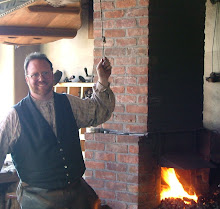This plow is over two centuries old, and represents a style of plow technology brought here by settlers of Dutch decent. Plow technology was rapidly evolving, and only one generation later this style was no longer made. But a working plow is a valuable item, and the great wear to the wooden parts of the plow suggest it was used for a considerable length of time. All plows of this era were made of wood, iron, and steel parts. The wooden parts would wear and be repaired or replaced by the farmer or blacksmith.
The wear patterns on this plow are interesting. The heart of the plow is the plow point. It is a very complicated forging made up from multiple parts of wrought iron welded in the forge. The smooth and rounded edges of all surfaces document years of abrasion and wear from plowing.
This early style of plow was made in a time when iron was terribly expensive. Anything that could be made from wood instead of iron was made from wood. Not only are the handles and main beam wood, but even part of the moldboard that turns the soil is wood.
Years of use have taken their toll. An iron bracket connects the front wheel truck to the plow beam. The bracket is held in place by friction and a wooden peg. Look at the wear of the wooden wheel carriage into the hardwood of the beam! Years or even decades of use have worn a groove over an inch into the hardwood beam. The underside of the wheel truck is a hardwood block. This block would be pushing through dead weeds and also be rubbing on the dirt and sod of the previous row’s furrow. We think of grass and plowed dirt as soft. But look how every surface of this block is worn, rounded, and shaped by the abrasion of soft dirt and grass! This piece is probably original to the plow when it was made.
What a grand old tool. The evidence of wear on the handle, plow beam, iron point, and wheel truck tell part of the story of this old girl and the farm family that used her. A family made their living and earned the grain for their daily bread by use of this plow. It is with great respect that we preserve her so that her story can be read by future generations.







Great post, it's hard to belive something so old and used so hard can last. Glad it was saved.
ReplyDeleteis like a piece of art
ReplyDeleteHi,
ReplyDeleteI am in the proccess of training two oxen.
I am planning ahead and looking for suggestions on a stoneboat, plow, cart etc.
Also any yoke suggestions are welcome.
Richard,
ReplyDeleteI'll ask our Farmers for suggestions. I know that there are a lot of Draft Oxen pulling contests at fairs in Mass., Vermont, and Maine. The competitors often also make and sell gear.
A stone boat is a good place to start when making draft equipment. It is very simple, is pulled with a chain, and is often used to get oxen used to pulling a little weight. They can be started training with it unloaded, and gradually get used to a litte weight over time. But I'm not a draft expert, so I'll go consult them and get back to you!
Steve
Do you have some bellows pictures dissasembled so we can saw how bellows are made.I am intersted in bellows design
ReplyDelete